Yogasana for adolescent girls
Yogasana for adolescent girls
- Stading Poses
- Tadasana (Palm Tree Pose)
- Vrikshasana(Tree Pose)
- Pada-hastasana (Hands to Feet Pose)
- Trikonasana (Triangle Posture)
- Garudasana (The Eagle pose)
- Sitting Postures
- Padmasana (The Lotus Pose)
- Vajrasana (The Diamond Pose)
- Bhadrasana (The Auspicious Pose)
- Ushtrasana (The Camel Pose)
- Shashakasana
- ArdhaMatsyendrasana
- Gomukhasana
- Prone Postures
- Supine Postures
Stading Poses
Tadasana (Palm Tree Pose)
The Name
.png) Body takes the shape of a palm tree in the final position of this pose; hence the name.
Body takes the shape of a palm tree in the final position of this pose; hence the name.
Technique
- Starting Position: Stand erect with feet two inches apart, arms by the sides of the body.
- Interlock the fingers, turn the palms outwards, inhale; rise the arms up, stretch the body up and bring it in a straight line
- Look in front; raise the heels; balance the body on toes and maintain the pose for few seconds with normal breathing.
- Exhale, bring the heels and hands down. Release the interlock of the fingers and come to starting position
Benefits:
- It helps to remove lethargy and make one to become more active.
- It helps to improve concentration.
Caution: -
- Those who have the complaints of reeling sensation, knee and ankle joints injuries should avoid this practice.
Vrikshasana(Tree Pose)
.png) The Name
The Name
Vriksha’ means ‘tree’. In the final position the body takes the shape of a tree. Hence, it is named Vrikshasana.
Technique
- Stand erect with feet together, arms by the sides of the body.
- Exhaling, bend the right leg; and place the right foot on the inside of the left thigh.
- Balance on one foot. Inhale, take both the arms up above the head without bending elbows and join both the palms together in namaskara mudra.
- Stay in this position for a few seconds while breathing normally.
- Exhale; come back and bring right foot down and arms by the sides of the body.
- Relax and then repeat the same procedure with left leg.
Benefits:
- It helps to improve concentration and bring neuro-muscular co-ordination.
Caution:
- Avoid this asana in case of vertigo
Pada-hastasana (Hands to Feet Pose)
The Name
.png) In the final position ofthis asana, hands are brought down and placed beside the feet; hence the name.
In the final position ofthis asana, hands are brought down and placed beside the feet; hence the name.
Technique
- Stand erect with feet together, arms by the sides of the body.
- Inhale, slowly raise the arms over the head and stretch the body up from the waist.
- Exhale, bend forwards from the waist without arching the back.
- Place the palms on the ground besides the feet. Maintain this position for a few seconds.
- Inhale, slowly come back to the standing position with arms up over the head.
- Exhale, bring the arms down to the sides of the body.
Benefits:
- It helps to make the spine flexible; improves digestion and memory.
Caution:
- In case of lower backache and spinal injuries, this practice should be avoided.
Trikonasana (Triangle Posture)
The Name
1.png) In the final position ofthis asana, hands are brought down and placed beside the feet; hence the name.
In the final position ofthis asana, hands are brought down and placed beside the feet; hence the name.
Technique
- Stand erect with feet 2-3 feet apart and arms by the sides of the body.
- Inhale; slowly raise both the arms sideways up to the shoulder level till they are horizontal.
- Turn the right foot at 90 degree.
- Exhale, slowly bend from the waist to the right side; and place the right hand behind the right foot.
- Keep the left arm up in straight position, thus, two arms making a line at 1800. Now, turn the left palm forward.
- Turn the head; and look up at the fingers of left hand. Maintain this position for few seconds.
- Now inhale slowly, lift the right hand; raise the trunk; and bring the arms up to the shoulder level and keep the arms down by the side of body.
- Repeat the asana from the left side as well.
Benefits:
- It helps to improve digestion, lungs capacity and brings alertness.
- Helps to reduce stress and anxiety.
Caution:
- Please avoid the practice of this asana in cases of migraine, slipped disc, and sciatica.
Garudasana (The Eagle pose)
The Name
.png) In the final position of this pose, the body looks like that of an eagle; hence the name
In the final position of this pose, the body looks like that of an eagle; hence the name
Technique
- Stand erect with feet together, arms by the sides of the body.
- Rise the right leg and take it round the left leg from front of the body like creeper
- Follow the same procedure with the arms, stretch the body; relax and maintain the pose for a few seconds
- Repeat the same standing on left leg
Benefits:
- Helps in body alignment.
- Nourishes and helps to develop nerves and bones of vertebral column.
Caution:
- Children with knee, ankle and wrist injuries should avoid this.
Sitting Postures
Padmasana (The Lotus Pose)
The Name
.png) Padam means Lotus. The body takes the shape of lotus in the final position of this posture hence, its name is Padmasana.
Padam means Lotus. The body takes the shape of lotus in the final position of this posture hence, its name is Padmasana.
Technique
- Sit on the floor with legs stretched out and spine erect.
- Fold the knees, place left foot on the right thigh and right foot on the left thigh. Knees should be touching the ground.
- Place the hands in Jnana or Chin mudra
- Keep the neck and back straight.
- Close the eyes and relax the whole body
Benefits:
- Pamasana helps to induce mental calmness and tranquility.
Caution:
- In case of severe arthritis, slip disc, knee injuries and ankle pain this asana should be avoided.
Vajrasana (The Diamond Pose)
The Name
.png) Vajra means diamond or thunderbolt.
Vajra means diamond or thunderbolt.
Technique
- Sit on the floor in kneeling position and big toes joined together.
- Position the buttocks in the space between the heels and place palms on the knees.
- Keep the spine erect and observe your breath.
Benefits:
- This asana is good for digestion.
Caution:
- In case of joint pain and varicose vein this should be avoided.
Bhadrasana (The Auspicious Pose)
The Name
.png) Bhadra means Auspicious. This asana destroys many diseases.
Bhadra means Auspicious. This asana destroys many diseases.
Technique
- Sit on the ground with legs stretched out.
- Fold the legs from knees and join both soles together.
- Hold the ankles by the hands and touch the heels to the perineum.
- Knees should touch the ground and spine should be kept straight.
Benefits:
- This asana is good for lumber region and keeps it healthy.
Ushtrasana (The Camel Pose)
The Name
.png) ‘Ushtra’ means ‘camel’. In this asana, the body takes shape of a camel; hence the name.
‘Ushtra’ means ‘camel’. In this asana, the body takes shape of a camel; hence the name.
Technique
- Sit down in Vajrasana and stand on your knees. Keep the knees and feet 12 inches apart.
- Inhaling, carefully bend backward without jerking.
- Exhale, place the right palm on right heel; and left palm on left heel. Try to keep the thighs vertical to the floor with the head tilted backward.
- Hold the posture for 10 to 20 seconds or as long as comfortable.
- Slowly inhale, come back to vajrasana.
Benefits:
- This asana regulates the functioning of thyroid glands and makes the spine flexible
Caution:
- In cases of vertigo and hernia this asana should be avoided.
Shashakasana
The Name
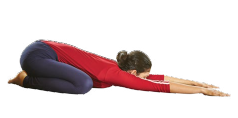 Shashanka means ‘hare in the lap’ or moon’. In this body takes the shape of a hare; hence, the name.
Shashanka means ‘hare in the lap’ or moon’. In this body takes the shape of a hare; hence, the name.
Technique
- Sit in Vajrasana with opened knees.
- Inhale, stretch the arms upward.
- Exhale, bend forward from the waist with the arms straight.
- In the final position chin and chest should be placed on the ground.
- Maintain the posture for a while with normal breathing.
- Slowly inhale, come back to initial position.
Benefits:
- It helps to reduce stress and anger.
Caution:
- In a case of slip disc and knee pain this asana should be avoided.
ArdhaMatsyendrasana
The Name
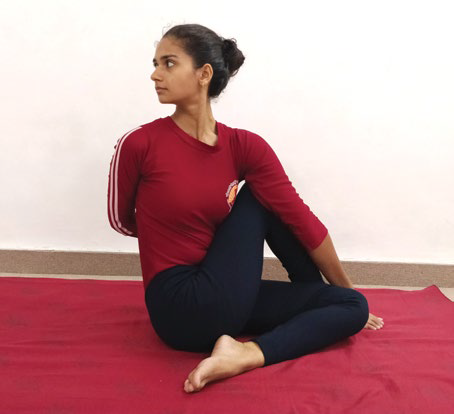 It is simply version of Matsyendrasana.
It is simply version of Matsyendrasana.
It is named after Yogi Matsyendranath.
In this asana, spine is twisted.
Technique
- Sit straight with stretching your legs in front of you.
- Bend your left leg and try to touch your feet to your right buttock
- Bring your right leg outside the left knee. Touch your feet to the ground. Keep your spine erect.
- Exhale and turn your upper body to the right. Hold your right feet with left hand and wrap your right hand behind the back
- Breathe normally and hold this posture for 20 to 30 seconds.
- Now release this posture and repeat it on the other side.
Benefits:
- This is good for adrenal glands, kidney, liver and spleen.
Caution:
- Must be avoided for children with severe spinal injuries.
Gomukhasana
The Name
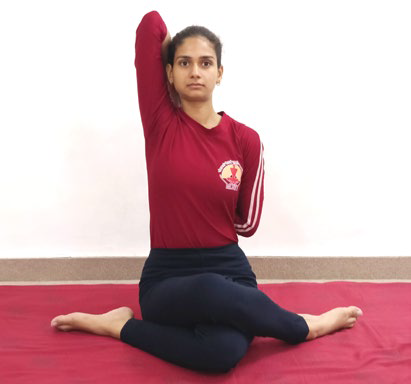 Gomukha consists of two words: ‘go’ meaning ‘cow’; and ‘mukha’ meaning ‘face’. In this asana, the knees, thighs and calves together make a form that resembles cow’s face.
Gomukha consists of two words: ‘go’ meaning ‘cow’; and ‘mukha’ meaning ‘face’. In this asana, the knees, thighs and calves together make a form that resembles cow’s face.
Technique
- Sit erect with legs stretched out.
- Fold left leg by the side of right hip same as right leg by the side of left hip.
- Take left arm over the shoulder and take right arm behind the back, down up.
- Interlock the fingers and maintain it with normal breathing.
- Repeat the same by changing the position of legs and hands.
Benefits:
- It is a good practice to improve lungs capacity.
Caution:
- Avoid this asana in case of joint injuries, acute pain in shoulders and piles problem.
Prone Postures
Makarasana
The Name
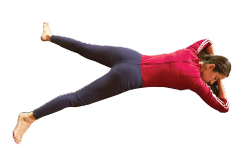 Makarasana is a relaxing posture. ‘Makara’ means ‘crocodile’. In this asana, the body resembles a resting crocodile, hence the name.
Makarasana is a relaxing posture. ‘Makara’ means ‘crocodile’. In this asana, the body resembles a resting crocodile, hence the name.
Technique
- Lie down in prone position.
- Spread the legs apart so that heels face each other.
- Fold the arms; and put them beneath the forehead one hand on the other.
- Close the eyes and relax. Hold the position for 20 to 30 seconds or as long as comfortable.
Benefits:
- It removes mental and physical fatigue and is good for reliving asthma, cervical and sciatica pain.
Bhujangasana
The Name
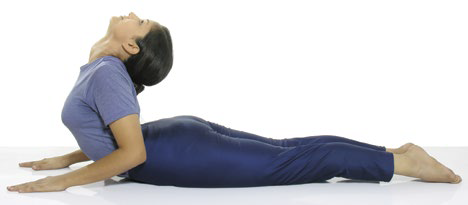 Bhujanga means cobra. The final position of this asana resembles the shape of cobra.
Bhujanga means cobra. The final position of this asana resembles the shape of cobra.
Technique
- Lie down in prone position then join the feet and place both hands under the shoulders, elbows pointed upward by the waist.
- Inhale, raise the upper body up to the navel.
- Hold the position for a while with normal breathing.
- Exhale come back to the initial position and relax in makrasana.
Benefits:
- It stimulates the digestive, reproductive and urinary systems.
Caution:
- It is strictly prohibited for the people suffering from hernia and abdominal injuries.
Shalabhasana
The Name
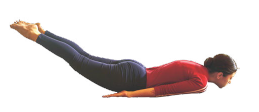 Shalabhasana takes its name from ‘shalabha’ which means ‘locust’. In the final posture, body resembles a locust or grasshopper; hence the name.
Shalabhasana takes its name from ‘shalabha’ which means ‘locust’. In the final posture, body resembles a locust or grasshopper; hence the name.
Technique
- Lie down in prone position with legs together and hands below the thighs.
- Inhale, slowly lift the legs upwards as high as possible. Chin should be on the ground
- Maintain the position for 10 to 20 seconds or as long as comfortable.
- To come back, bring the legs down to the floor and relax in makrasana
Benefits:
- It strengthens muscles in the lower backand makes the
spine flexible.
Caution:
- This asana should be avoided in cases of cardiac complaints, hernia or ulcers in stomach.
Dhanurasana
The Name
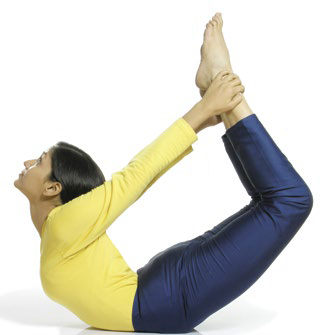 Dhanurasana gets its name from ‘dhanur’ which means ‘bow’. In the final posture, body looks like a bow with the strings; hence, the name.
Dhanurasana gets its name from ‘dhanur’ which means ‘bow’. In the final posture, body looks like a bow with the strings; hence, the name.
Technique
- Lie down in prone position with legs together and arms beside the body.
- Exhale and hold the ankles with hands.
- Inhaling, lift the thighs, head and chest as high as possible on lower abdomen. Maintain the position comfortably for 10 – 20 seconds.
- Exhale come back to starting position and relax in makrasana
Benefits:
- It regulates functioning of adrenal and thyroid glands; and also of digestive and excretory systems.
- It strengthens joints of shoulders, spine, knees and ankles; and removes stiffness of these organs.
Caution:
- In case of hernia, peptic ulcers, colitis, appendicitis should not perform
Supine Postures
Ardhahalasana
The Name
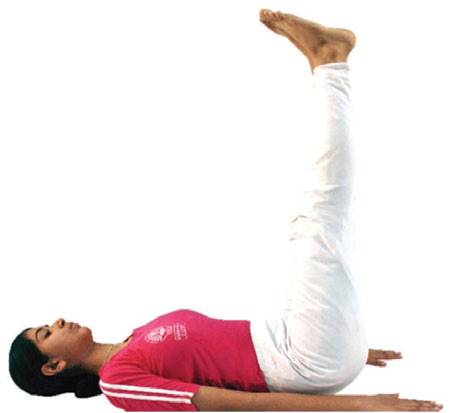 Ardha means half and ‘Hala’ means plough. This posture is known as ArdhaHalāsana because in its final position, the body resembles half the shape of an Indian plough.
Ardha means half and ‘Hala’ means plough. This posture is known as ArdhaHalāsana because in its final position, the body resembles half the shape of an Indian plough.
Technique
- Take supine position, keep hands by the sides of thighs, palms resting on the ground.
- Slowly raise your legs together without bending at knees and stop at 30° angle.
- After few seconds raise your legs further up to 60° angle and maintain the position.
- Now slowly raise the legs at 90° angle. This is the final position of the ArdhaHalāsana.
- The body from hip to shoulder should be kept straight.
- Maintain this position as long as comfortable.
- Slowly legs at 90° angle and then on the ground without lifting the head.
Benefits:
- This āsana is beneficial for dyspepsia and constipation.
- The practice of this āsana is useful in cases of diabetes, pilesand throat related disorders.
- This is very beneficial for Hypertensive patients but needs topractice with care.
Caution:
- Avoid this practice in case of abdominal injuries, hernia etc.
Setubandhasana
The Name
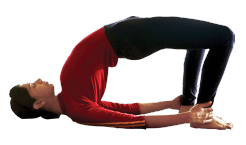 Setubandha means formation of bridge. In this posture, the body ispositioned like a bridge, hence the name.
Setubandha means formation of bridge. In this posture, the body ispositioned like a bridge, hence the name.
Technique
- Bend both the legs at the knees and bring the heels near the buttocks.
- While holding both the ankles firmly keep the knees and feet in one straight line.
- Inhale; slowly raise your buttocks and trunk up as much as you can to form bridge.
- Remain in this position for 10-30 seconds, with normal breathing.
- Exhale, slowly return to the original position and relax in Śavāsana.
Benefits:
- Relieves depression and anxiety and strengthens lower back muscles.
- Stretches abdominal organs, improves digestion and helpsto relieve constipation.
Caution:
- People suffering from ulcers and hernia, and women inadvanced stages of pregnancy should not practice this asana.
Pavanamuktasana
The Name
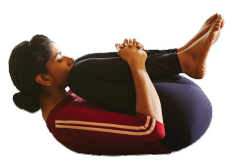 This asana gets its name from ‘pavana-mukta’ where ‘pawana’ means ‘wind’; and ‘mukta’ means ‘relieved’. As the name suggests, this asana helps in releasing trapped wind from the stomach and intestine.
This asana gets its name from ‘pavana-mukta’ where ‘pawana’ means ‘wind’; and ‘mukta’ means ‘relieved’. As the name suggests, this asana helps in releasing trapped wind from the stomach and intestine.
Technique
- Lie down on the back with legs together, arms beside the body, and palms resting on the floor.
- Inhaling, bend the legs and bring knees towards chest.
- Encircle the knees with both arms and hold them tightly.
- Exhaling, raise the head; touch the chin with the knees
- Maintain the position comfortably for 10 to 20 seconds.
- To come back, release the arms and unfold the legs and bring them to the floor.
- Relax with legs together on the floor and hands beside the body
Benefits:
- It helps in eliminating toxic gases from the stomach and intestine which improves digestion.
Caution:
- In case of abdominal injuries and severe back-pain should be avoided.
Sarvangasana
The Name
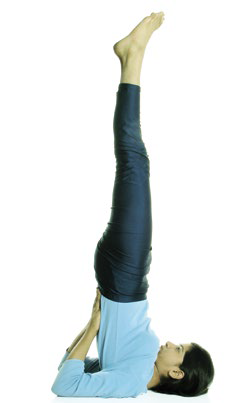 Sarvangasana consists of ‘sarva’ meaning ‘all’ or ‘whole’; ‘anga’ meaning ‘limbs of body’; and ‘asana’ meaning posture. It affects all parts of body; hence the name.
Sarvangasana consists of ‘sarva’ meaning ‘all’ or ‘whole’; ‘anga’ meaning ‘limbs of body’; and ‘asana’ meaning posture. It affects all parts of body; hence the name.
Technique
- Lie down in supine position with arms beside the body and palms resting on the floor.
- Inhaling, slowly raise the legs without bending them at knee from 30 to 90 degree angle.
- Hold at 90 degree angle with the support of palm on the back.
- Place the chin against the chest region.
- Gradually come back to normal position and relax.
Benefits:
- It helps in regulating functioning of endocrine glands, specially the thyroid glands.
Caution:
- This asana should be avoided in cases of neck pain, epilepsy, high blood pressure and pain in lumbar region.
Chakrasana
The Name
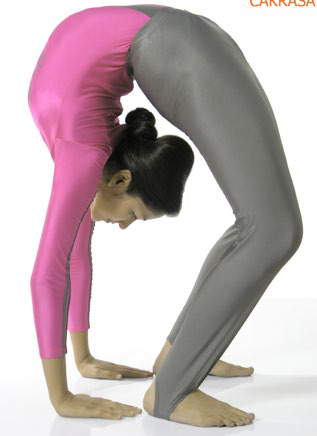 Chakrasana gets its name from the word ‘chakra’ which means ‘wheel’. In this asana, the body takes the shape of a wheel; hence the name.
Chakrasana gets its name from the word ‘chakra’ which means ‘wheel’. In this asana, the body takes the shape of a wheel; hence the name.
Technique
- Lie down in supine position.
- Bend the legs at the knees; and bring the heel close to buttocks
- Raise the arms; place the palms on the floor beside the head with fingers pointing towards the shoulders.
- Inhale, raise the body on the arms and feet and make arch in the back. Now, gently, drop the head down.
- Maintain this position with normal breathing.
- Exhale, come back to normal position and relax.
Benefits:
- It removes stiffness from the body; and makes the spine flexible.
Caution:
- This asana should be avoided in cases of weak wrist, high blood pressure, hernia, abdominal problems and vertigo.
Shavasana
The Name
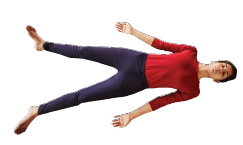 This is a relaxing posture. In this posture the body remains still like a corpse; hence the name.
This is a relaxing posture. In this posture the body remains still like a corpse; hence the name.
Technique
- Lie down in supine position.
- Keep the feet 2 – 3 feet apart with toes pointed outward.
- Place the hands placed about six inches away from the body. Keep the fingers relaxed
- Keep the head in a straight comfortable position.
- Gently close the eyes; be aware of your breath.
Benefits:
- It relaxes the body and mind; and eliminates physical and mental fatigue.
- It boosts up energy level.
Caution:
- This should be avoided in cases of depression and low blood pressure.
Source : POSHAN Abhiyaan
Last Modified : 1/11/2024
This topic provides information related to Surya N...
This topic contains the information related to Men...
This topic provides information about Adolescent H...
This topic provides information about Adolescent G...
